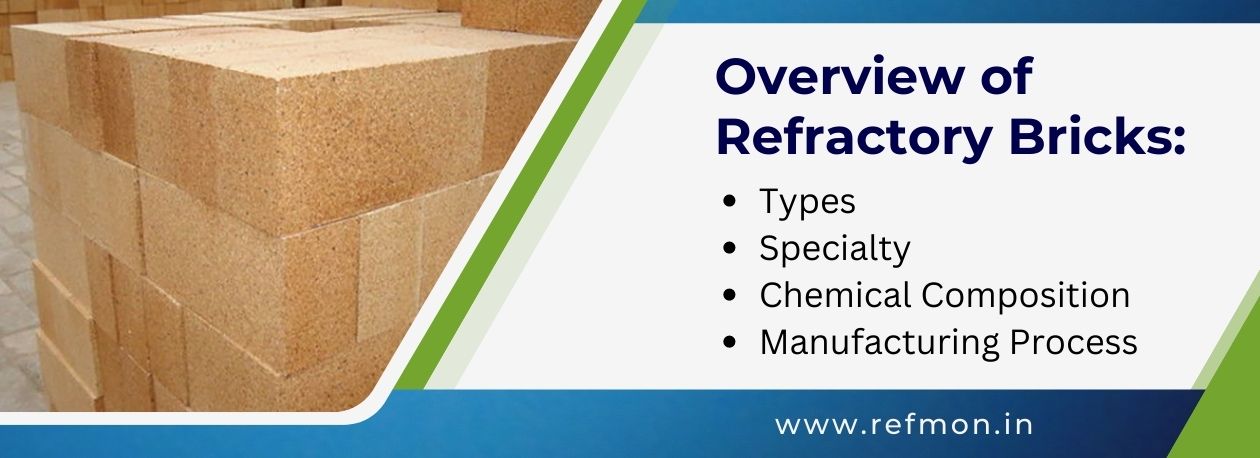
Overview of Refractory Brick: Types, Specialty, Chemical Composition, Manufacturing Process
Refractory Bricks (Fire Bricks): Refractory bricks are also known as fire bricks. These are special brick designs which can withstand high temperatures, chemical environments and mechanical stress.
They are used in different industries like cement, glass, ceramic, petrochemicals and more. They can serve as linings for kilns, reactors, furnaces and other high temperature equipments. These refractory bricks are very crucial in maintaining industrial processes like structural integrity and efficiency.
Specialty of Fire Bricks
The specialty of fire bricks lies in their ability to withstand extremely high temperatures while maintaining their structural integrity and thermal insulating properties. They are designed to resist thermal shock, chemical attack, and mechanical abrasion, making them essential for applications where regular construction materials would fail. There are several fire brick manufacturers where fire bricks can be made anytime.
Chemical Composition of Refractory Bricks
The chemical composition of refractory bricks differs depending on their intended usage. Some of the common constituents are silica (SiO2), alumina (Al2O3), and other metal oxides. These constituents help understand the refractory's ability to resist heat, corrosion, and other environmental factors.
Manufacturing Process of Fire Bricks
There are certain steps involved in the manufacturing process of fire bricks. Let us take a look at those -
1) Digging:
First comes digging when raw materials such as silica, clay, alumina, and magnesia are extracted from quarries or mines. These are chosen depending on the properties of the final refractory product created.
2) Weathering:
The extracted raw materials are exposed to weathering. This can help reduce moisture content and improve the durability. As a result it becomes easy to form acid proof bricks later.
3) Tempering:
The raw materials are mixed with water to form a plastic clay-like mixture. This mixture is then tempered, which involves kneading as well as rolling to achieve uniform consistency and eliminate any kind of air pockets.
4) Moulding:
Molds help shape any mixture into a desired brick form. The process of molding can be done via different methods like extrusion, pressing, or casting.
5) Burning:
The molded bricks are fired in kilns at very high temperatures starting from around 1300°C to 1800°C (2372°F to 3272°F). It depends on the type of brick as well as its application. This firing process results in a dense and durable refractory structure.
Types of Refractory Bricks
There are several types of refractory bricks like castable refractory bricks. Here are some common types -
1. Basic Refractory Bricks
Basic refractory bricks are the ones which mostly consist of basic oxides such as magnesia (MgO) and dolomite (a combination of calcium magnesium carbonate, CaMg(CO3)2). Such materials have a very high melting point and have excellent resistance to alkaline substances. Basic refractories are mostly used in applications where they come in contact with basic (alkaline) slags, ashes, and gases. Steel plants use these refractory bricks to line the basic oxygen furnace (BOF) and electric arc furnace (EAF). These environments contain basic slag formed during the steelmaking process. They are used in cement kilns as well.
2. Acid Refractory Bricks
Acid refractory bricks consists of silica (SiO2) or materials rich in silica. These are designed to withstand acidic conditions and resist corrosion by acidic slags and gases. Acid refractories are widely used in industries where materials come in contact with acidic substances. Acid refractories are used in constructing glass furnaces, which operate at high temperatures and in the presence of molten glass, that can have acidic properties.
3. Neutral Refractory Bricks
These neutral refractory bricks are also known as alumina-silicate refractories. These are made of materials with balanced alumina (Al2O3) and silica (SiO2) composition. They have good resistance to acidic and basic environments, making them versatile for different applications. Neutral refractories are used in applications involving non-ferrous metals like aluminum and copper. They are used in furnaces and reactors for smelting and refining processes. These refractories are also used in petrochemical plants where conditions can vary depending on acidic and basic due to the nature of the chemicals processed.